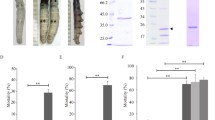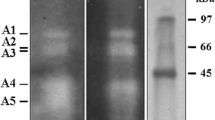Abstract
One or more proteinaceous factors with insecticidal activities in the locust pathogen Serratia marcescens HR-3 culture filtrates were found to cause the death of grassland locusts. A novel insecticidal protein was purified to homogeneity. It was a monomer of 61 kDa. The purified protein showed a strong insecticidal effect with a median lethal dosage of 12.1 μg locust−1 and contained a high level of protease activity (101 U ml−1). Insecticidal activity was significantly decreased when the protein was pretreated with ethylene diamine tetraacetic acid and 1-10-phenanthroline, and it was restored when the treated protein was incubated with Zn2+. The N-terminal amino acid sequence of insecticidal protein showed sequence similarity with metalloprotease from S. marcescens SM6 and Serratia spp. E15. Our results suggested that the factor primarily responsible for insecticidal activity toward locusts was a zinc-dependent 61-kDa metalloprotease.




Similar content being viewed by others
Literature Cited
Amare G, Berhanu AG (1997) Production of alkaline protease by an alkaliphilic bacteria isolated from an alkaline soda lake. Biotechnol Lett 19:479–481
Aucken HM, Pitt TL (1998) Antibiotic resistance and putative virulence factors of Serratia marcescens with respect to O and K serotypes. J Med Microbiol 47:1105–1113
Bowen DJ, Rocheleau TA, Grutzmacher CK, Meslet L, Valens M, Marble D, et al. (2003) Genetic and biochemical characterization of PrtA, an RTX-like metalloprotease, from Photorhabdus. Microbiol-SGM 149:1581–1591
Braunagel SC, Benedik MJ (1990) The metalloprotease gene of Serratia marcescens strain SM6. Mol Gen Genet 222:446–451
Brurberg MB, Nes IF, Eijsink VG (1996) Comparative studies of chitinases A and B from Serratia marcescens. Microbiology-SGM 142:1581–1589
Bulla LA, Jr, Rhodes RA, Julian GS (1975) Bacteria as insect pathogens. Annu Rev Microbiol 29:163–190
Dillon RJ (2000) Re-assessment of the role of the insect gut microbiota. XXI International Congress of Entomology, Brazil, August 20, 2000
Feng SL, Cao WP, Fan LH, Wang RY, Tsuguo M (2002) Identification of a Serratia marcescens stain and bioassay against Oedaleus infernalis Saussure. Chinese J Biol Control 18:158–161
Finney DJ (1971) Probit analysis, 3rd ed. London, UK: Cambridge-University Press
Hines DA, Saurugger PN, Ihler GM, Benedik MJ (1988) Genetic analysis of extracellular proteins of Serratia marcescens. J Bacteriol 170:4141–4146
Kurz CL, Chauvet S, Andres E, Aurouze M, Vallet I, Michel GP, et al. (2003) Virulence factors of the human opportunistic pathogen Serratia marcescens identified by in vivo screening. EMBO J 22:1451–1460
Legakis NJ, Nicolas KJ, Xilinas M, Papavassiliou J (1978) Differentiation of Serratia marcescens and Serratia liquefaciens by tests for lipase and phospholipase production. J Med Microbiol 11:3225–3231
Li X, Tetling S, Winkler UK, Jaeger KE, Benedik MJ (1995) Gene cloning, sequence analysis, purification, and secretion by Escherichia coli of an extracellular lipase from Serratia marcescens. Appl Environ Microbiol 61:2674–2680
Lowry OH, Rosebrough NJ, Farr AL, Randall RJ (1951) Protein measurement with the folin phenol reagent. J Biol Chem 193:265–275
Nakahama K, Yoshimura K, Marumoto R, Kikuchi M, Lee IS, Hase T, et al. (1986) Cloning and sequencing of Serratia protease gene. Nucleic Acids Res 14:5843–5855
Nestle M, Roberts WK (1969) An extracellular nuclease from Serratia marcescens. I. Purification and some properties of the enzyme. J Biol Chem 244:5213–5218
Schwyn B, Neilands JB (1987) Universal chemical assay for the detection and determination of siderophores. Anal Biochem 160:47–56
Stevenson JP, (1959) Epizootology of a disease of the desert locust, Schistocerca gregaria (Forskäl), caused by nonchromogenic strains of Serratia marcescens Bizio. J Insect Pathol 1:232–244
Yang FL, Volkmar B (2000) ShlB mutants of Serratia marcescens allow uncoupling of activation and secretion of the ShlA hemolysin. Int J Med Microbiol 290:529–538
Author information
Authors and Affiliations
Corresponding author
Rights and permissions
About this article
Cite this article
Tao, K., Long, Z., Liu, K. et al. Purification and Properties of a Novel Insecticidal Protein from the Locust Pathogen Serratia marcescens HR-3. Curr Microbiol 52, 45–49 (2006). https://doi.org/10.1007/s00284-005-0089-8
Received:
Accepted:
Published:
Issue Date:
DOI: https://doi.org/10.1007/s00284-005-0089-8




